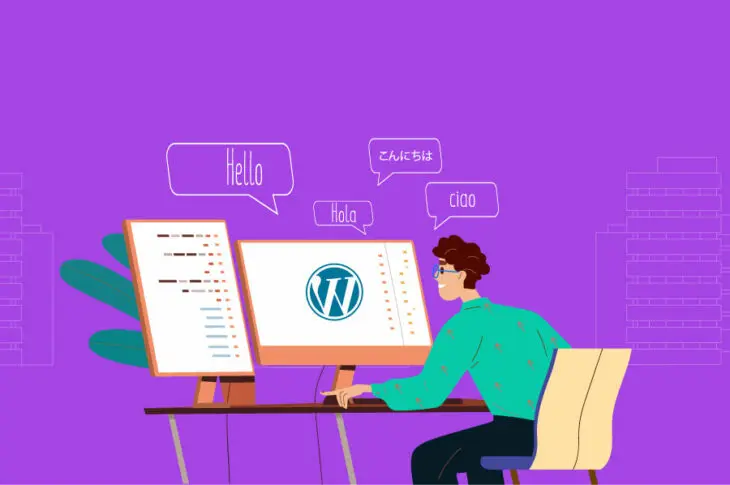
How to create a multilingual WordPress website?
In today's globalized world, businesses and organizations are increasingly seeking to expand their reach and connect with audiences across different languages and cultures. A multilingual website is a powerful tool that allows you to communicate effectively with a diverse range of visitors, breaking down language barriers and fostering inclusivity. By offering your content in multiple languages, you can enhance user experience, increase engagement, and ultimately drive more traffic and conversions.

Why create a multilingual website on WordPress?
WordPress, the world's most popular content management system (CMS), offers a flexible and scalable platform for creating multilingual websites. With its extensive plugin ecosystem and customization options, WordPress empowers you to seamlessly integrate multilingual functionality into your website. Here are some compelling reasons to create a multilingual WordPress website:
Expand Your Reach: By translating your content into multiple languages, you can tap into new markets and attract a global audience, significantly increasing your website's visibility and potential customer base.
Improve User Experience: Providing content in visitors' native languages enhances their overall experience, making it easier for them to understand and engage with your website. This can lead to higher conversion rates and customer satisfaction.
Boost SEO Performance: Search engines prioritize websites that offer localized content, as it better aligns with users' search queries and preferences. A multilingual website can improve your search engine rankings and organic traffic.
Enhance Brand Reputation: Demonstrating a commitment to inclusivity and catering to diverse audiences can enhance your brand's reputation and credibility, fostering trust and loyalty among your customers.

Choosing the right multilingual plugin for your WordPress site
WordPress offers a wide range of multilingual plugins to help you create and manage a multilingual website. Two of the most popular and feature-rich options are WPML (WordPress Multilingual Plugin) and TranslatePress. Here's a brief overview of each:
-
WPML: WPML is a premium plugin that provides a comprehensive solution for creating and managing multilingual WordPress websites. It offers advanced translation management tools, seamless integration with popular page builders, and support for various content types, including posts, pages, custom post types, and taxonomies.
-
TranslatePress: TranslatePress is a freemium plugin that offers a user-friendly interface for translating your WordPress website. It supports visual translation, allowing you to translate content directly on the frontend of your website, and includes features like automatic user language detection and translation management.
When choosing a multilingual plugin, consider factors such as your budget, the complexity of your website, the number of languages you need to support, and the plugin's compatibility with your existing WordPress theme and plugins.
Installing and configuring the multilingual plugin
Once you've chosen the multilingual plugin that best suits your needs, it's time to install and configure it. Here's a general overview of the process:
-
Install the Plugin: Navigate to the "Plugins" section in your WordPress dashboard, search for the plugin you've chosen, and click "Install" followed by "Activate."
-
Set Up Languages: After activating the plugin, you'll be prompted to select the languages you want to support on your website. This step is crucial, as it will determine the available language options for your content.
-
Configure Plugin Settings: Most multilingual plugins offer a range of settings and options to customize the translation process, language switchers, and other aspects of your multilingual website. Take the time to explore and configure these settings to align with your specific requirements.
-
Import or Create Translations: Depending on the plugin, you may have the option to import existing translations or create new ones manually. If you plan to translate your content yourself, you'll need to navigate to the translation interface and begin the translation process.
-
Set Up Language Switchers: Language switchers are essential for allowing visitors to switch between different language versions of your website. Most multilingual plugins provide options to customize the appearance and placement of these switchers.
-
Configure Navigation Menus: Ensure that your navigation menus are properly set up to display the appropriate language versions of your content. This may involve creating separate menus for each language or using the plugin's built-in menu translation features.

Translating your website content
Once your multilingual plugin is installed and configured, you can begin translating your website's content. The translation process may vary depending on the plugin you've chosen, but generally, you'll have the following options:
Manual Translation: If you or members of your team are proficient in the target languages, you can manually translate your content using the plugin's translation interface. This approach allows for complete control over the translation process but can be time-consuming for larger websites.
Professional Translation Services: Many multilingual plugins offer integration with professional translation services, such as WPML's Translation Management system or TranslatePress' collaboration with third-party translation providers. These services can streamline the translation process and ensure high-quality translations, but they often come at an additional cost.
Automatic Translation: Some plugins offer automatic translation features, which use machine translation engines to generate initial translations of your content. While this can be a quick solution, automatic translations may lack accuracy and nuance, and it's recommended to review and refine them manually.
Regardless of the translation method you choose, it's essential to ensure consistency and accuracy across all language versions of your website. Consider establishing translation guidelines, using glossaries, and involving native speakers or professional translators to maintain high-quality translations.
Managing language switchers and navigation menus
Language switchers and navigation menus play a crucial role in providing a seamless multilingual experience for your visitors. Most multilingual plugins offer various options for customizing and managing these elements:
Language Switchers: Language switchers allow visitors to switch between different language versions of your website. You can customize the appearance, placement, and behavior of these switchers to ensure a consistent user experience across all pages. Some plugins even offer advanced features like automatic language detection based on the visitor's location or browser settings.
Navigation Menus: Depending on your plugin, you may need to create separate navigation menus for each language or use the plugin's built-in menu translation features. Ensure that your navigation menus are properly configured to display the appropriate language versions of your content, providing a clear and intuitive way for visitors to navigate your multilingual website.
Breadcrumb Navigation: Breadcrumb navigation can be particularly helpful for multilingual websites, as it provides visitors with a visual representation of their current location within the website's structure. Many multilingual plugins offer options to translate and display breadcrumb trails in the appropriate language.
Language-Specific URLs: Some plugins allow you to configure language-specific URLs, which can improve user experience and search engine optimization (SEO). For example, instead of using a query parameter (e.g., ?lang=fr), you can have dedicated URLs for each language version (e.g., example.com/fr/).
Carefully managing language switchers and navigation menus, you can ensure a seamless and intuitive experience for visitors, regardless of their preferred language.

Optimizing your multilingual website for SEO
Creating a multilingual website can significantly impact your search engine optimization (SEO) efforts. Here are some best practices to optimize your multilingual WordPress website for better search engine visibility:
Hreflang Tags: Hreflang tags are HTML tags that help search engines understand the language and geographic targeting of your website's content. By implementing hreflang tags correctly, you can ensure that search engines serve the appropriate language version of your content to users based on their location and language preferences.
Multilingual Sitemaps: Sitemaps are essential for helping search engines discover and index your website's content. Many multilingual plugins offer options to generate separate sitemaps for each language version of your website, ensuring that all your content is properly indexed and accessible to search engines.
Multilingual SEO Plugins: Consider using SEO plugins specifically designed for multilingual websites, such as Yoast SEO Multilingual or Rank Math SEO. These plugins provide additional features and settings to optimize your website's multilingual content for search engines, including language-specific meta tags, XML sitemaps, and more.
Localized Content and Keywords: To rank well in different language markets, it's essential to create localized content and optimize it with relevant keywords for each target language. Avoid simply translating content from one language to another; instead, tailor your content to the cultural and linguistic nuances of each audience.
Consistent URL Structure: Maintain a consistent URL structure across all language versions of your website. This not only improves user experience but also helps search engines understand the relationship between different language versions of your content.
Language-Specific Social Media Profiles: Consider creating language-specific social media profiles to promote your multilingual content and engage with audiences in their native languages. This can help increase visibility, drive traffic, and improve your overall online presence.
These SEO best practices, you can ensure that your multilingual WordPress website is optimized for search engines, increasing its visibility and attracting targeted traffic from users across different languages and regions.
Testing and troubleshooting your multilingual website
Before launching your multilingual WordPress website, it's crucial to thoroughly test and troubleshoot all aspects of its functionality. Here are some steps to follow:
Cross-Browser and Device Testing: Ensure that your multilingual website displays and functions correctly across different web browsers (e.g., Chrome, Firefox, Safari) and devices (desktops, tablets, and smartphones). Test language switchers, navigation menus, and content rendering on various platforms.
Language Switcher Functionality: Test the language switcher thoroughly by switching between different language versions of your website. Verify that the content, navigation menus, and other elements are correctly translated and displayed in the selected language.
Translation Accuracy: Review all translated content for accuracy, consistency, and cultural appropriateness. Involve native speakers or professional translators to ensure high-quality translations and avoid any potential misunderstandings or offenses.
Broken Links and Redirects: Check for broken links or incorrect redirects, especially when switching between language versions. Ensure that all internal and external links are functioning correctly in each language.
Performance and Load Times: Monitor your website's performance and load times, particularly when serving content in multiple languages. Optimize images, leverage caching, and implement other performance optimization techniques to ensure a smooth user experience.
Accessibility and Compliance: Ensure that your multilingual website adheres to accessibility standards and complies with relevant laws and regulations, such as the General Data Protection Regulation (GDPR) or the Americans with Disabilities Act (ADA).
User Testing: Conduct user testing with individuals from your target audiences to gather feedback on the overall user experience, navigation, and content presentation. Address any issues or areas for improvement based on their feedback.
Testing and troubleshooting your multilingual WordPress website, you can identify and resolve potential issues before launch, ensuring a seamless and enjoyable experience for visitors across all languages and platforms.
Best practices for maintaining a multilingual WordPress website
Creating a multilingual WordPress website is just the first step; maintaining and updating it requires ongoing effort and attention. Here are some best practices to follow:
Regular Content Updates: Regularly update and refresh your website's content in all supported languages. Ensure that new or updated content is promptly translated and published to maintain consistency across all language versions.
Plugin and Theme Updates: Keep your WordPress installation, plugins, and themes up to date to benefit from the latest security patches, bug fixes, and feature enhancements. Test updates thoroughly before applying them to your live website to ensure compatibility with your multilingual setup.
Continuous Translation Management: Establish a clear process for managing translations, whether you're handling them internally or outsourcing to professional translation services. Maintain translation memories, glossaries, and style guides to ensure consistency across all language versions.
Monitoring and Analytics: Monitor your website's performance, user engagement, and traffic metrics across different language versions. Use analytics tools to identify areas for improvement and make data-driven decisions about content optimization and language targeting.
Collaboration and Workflow: If you have a team working on your multilingual website, establish clear roles, responsibilities, and workflows. Use project management tools and communication channels to streamline collaboration and ensure everyone is aligned.
Backups and Disaster Recovery: Implement a robustbackup strategy to protect your multilingual website's data and content. Regularly create backups and have a disaster recovery plan in place to minimize downtime and data loss in case of any issues or emergencies.
Continuous Testing and Optimization: Regularly test and optimize your multilingual website to ensure it remains up-to-date with the latest best practices, technologies, and user preferences. Conduct usability testing, gather user feedback, and make improvements based on your findings.
These best practices, you can maintain a high-quality, up-to-date, and well-functioning multilingual WordPress website, providing a consistent and engaging experience for visitors across all languages and regions.
FAQ

No, you don’t need to be fluent in multiple languages to create a multilingual WordPress site. Translation plugins like WPML offer automatic translation services, and you can also hire professional translators or use translation services to help with content translation.
There are several good options, but WPML (WordPress Multilingual Plugin) and Polylang are among the most popular and reliable. WPML is a paid plugin that offers extensive features, while Polylang has a free version with basic functionality and a paid version with more advanced options.
Yes, you can translate your website’s theme and plugins using translation plugins like WPML. They offer a “String Translation” feature that allows you to translate any text strings used in your theme and plugins.
Most translation plugins, including WPML, offer a built-in language switcher that you can add to your site’s menu, sidebar, or footer. You can customize its appearance and choose the most convenient location for your users.
Yes, with WPML, you can assign different domains or subdomains to each language version of your site. This setup can be beneficial for SEO and provides a more localized experience for users.
A multilingual site can improve your SEO by reaching a broader audience and ranking in multiple languages. WPML and other translation plugins automatically add hreflang tags, which help search engines understand which version of your content to show to users based on their language.
Yes, you can run a multilingual WooCommerce store using the WooCommerce Multilingual plugin. It allows you to translate product descriptions, checkout pages, and even manage different currencies for each language.
While automatic translations are convenient, they might not always be accurate. It’s recommended to review automatic translations manually or hire professional translators to ensure accuracy, especially for important pages like product descriptions or legal disclaimers.
Yes, for consistency, you should update content in all languages when you make changes to the original version. Translation management features in plugins like WPML help you track and manage updates across different languages.
You can offer multilingual customer support by using a support plugin that supports multiple languages, like WP Live Chat or Zendesk. Additionally, creating a multilingual FAQ page and knowledge base can help users find answers to their questions without needing direct support.
Conclusion
Creating a multilingual WordPress website is a powerful strategy for expanding your online reach, catering to diverse audiences, and enhancing your brand's global presence. By following the steps outlined in this guide, you can leverage the flexibility and scalability of WordPress to build a multilingual website that delivers an exceptional user experience across multiple languages.
Remember, the key to success lies in choosing the right multilingual plugin, carefully translating and managing your content, optimizing for search engines, and continuously maintaining and updating your website. With dedication and attention to detail, you can overcome language barriers and unlock new opportunities for growth and engagement in the global marketplace.
If you need assistance in creating or maintaining a multilingual WordPress website, feel free to contact me for professional services and expert guidance. I'll be happy to help you navigate the process and ensure a seamless multilingual experience for your visitors.
Useful References
-
WPML Documentation
The official WPML documentation offers in-depth guides and tutorials on how to set up and manage a multilingual WordPress website, including translating content, setting up language switchers, and optimizing for SEO. -
Polylang Documentation
Polylang’s official documentation provides detailed instructions on using the plugin to create a multilingual site, including how to translate posts, pages, media, categories, and more. -
WordPress Multisite Guide
If you’re considering using WordPress Multisite to create separate sites for each language, this official guide walks you through the setup process and configuration. -
WooCommerce Multilingual Documentation
Learn how to create a multilingual WooCommerce store with WPML’s WooCommerce Multilingual plugin. This guide covers product translation, multi-currency setup, and handling multilingual checkout processes. -
Yoast SEO for Multilingual Websites
Yoast SEO offers guidance on optimizing your multilingual website for search engines, including best practices for hreflang tags, sitemaps, and localized keyword research. -
Google Search Console - Hreflang Tags
Google’s official guide to implementing hreflang tags on your multilingual site, ensuring that the right language version of your content appears in search results. -
Content Delivery Networks (CDNs) for Global Sites
An introduction to CDNs and how they can improve the performance of your multilingual website by reducing latency and loading times for users around the world. -
Professional Translation Services
If you prefer professional translation services over automatic translation, platforms like One Hour Translation can connect you with skilled translators for accurate content translation. -
Multilingual Live Chat Software - Zendesk
Zendesk offers a live chat solution that supports multiple languages, making it easier to provide customer support to a global audience. -
Google Translate vs. Professional Translation: Which to Choose?
This article compares the pros and cons of using Google Translate versus professional translation services, helping you decide the best approach for your multilingual site.





